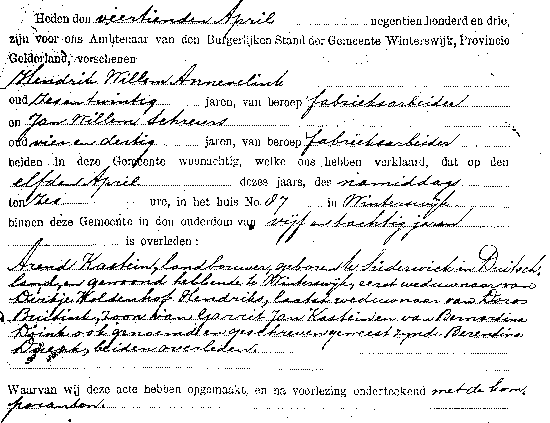HSN Data Sources - Death
This section will answer the following questions: what data can be found on a death certificate; who could declare a death; when should a death be reported; and how were the certificates processed?
Data on a death certificate
Deaths had to be reported to the registrar of the municipality in which they occurred and then they where entered in the death register. For each deceased person, Christian names and surname, age, occupation, municipality of birth and residence, and hour and day of death were recorded. The age was generally expressed in completed years. However, for persons younger that two at the time of death, ages was expressed in months; for persons younger than two months, in weeks; for those younger than two weeks, in days; and for children less than two days old, in hours.
The place of residence was usually given as a detailed address, required by the collector of death duties. The exact address where the death occurred was not required by law. In practice, however, the place of death within the municipality was often recorded, particularly in the older certificates. In case the deceased had been married or widowed, the name of the husband or wife had to be recorded. Until 1935 this concerned only the present or last partner of the deceased. After 1935 all former partners were to be recorded in chronological order, without the reason for marriage dissolution. Christian names and surnames, occupation and place of residence of the parents of the deceased were to be recorded as well. If the parents were already deceased, only their names and the fact that they had died were recorded. Before the introduction of the population register, information on the parents of the deceased was often incomplete.
Who could declare a death
The notification could only be done by someone who had personal knowledge of the death of the person concerned. In the 19th century the declarant was generally a relative or acquaintance of the deceased. Later on, notifications were mostly made by undertakers. After 1935 the family connections between the declarant and the deceased was no longer made explicit. Another change was that formerly two informants had to declare the death. They were supposed to have made certain that the death had occurred. Therefore, unlike birth certificates, death certificates could not be signed by 'rented' informers. After 1935 only one informant was required.
When a death should be reported
A time period within which notification had to take place was not mentioned by law. But no burial could take place without a written permission from the registrar, which could not be given within 36 hours after the death. Because it was most convenient to give this permission at the time of notification, registrars were strongly advised not to register a death before the 36 hours had passed.
How death certificates were processed
In case the deceased was a resident of a municipality other than the municipality of death, the registrar had to send an extract of the death certificate to the registrar of the municipality of residence, where it was included in the death register. In 1955 these extracts were abolished because the population administration was assumed to have achieved complete coverage of all vital events.
On the right: Death certificate 1903, Winterswijk (Gelderland)



